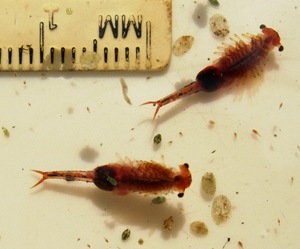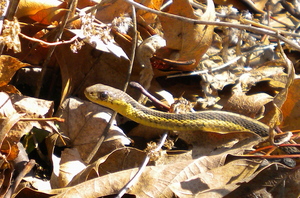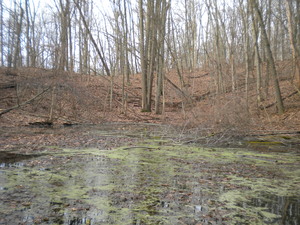Pondcast 11: Dead tadpoles found in pond; Authorities suspect natural causes

Adult female fairy shrimp (photo taken 28 April 2008) - notice the egg sacs
Stefan Szumko | Contributor
Pondcast Week 11 - March 14-20, 2010
This week brings to mind the Smothers Brothers song, The Shrimp, recorded on their album, “It Must Have Been Something I Said”.
First you put your little foot way up tight. Then you swing it to the left and you swing it to the right. You swing it all around, then you swing it…to the right. Turn around and turn around and that’s the shrimp.
This week heralds the official start of the spring phase of our vernal pool, known as Black Pond. Sometime between Tuesday and Friday, the ice on the pond melted completely. Tuesday, there was a layer of ice approximately five centimeters deep just below the surface of the pond. On Friday, fairy shrimp were first sighted.
Fairy shrimp are freshwater shrimp, living only in larger vernal pools.
Recall that vernal pools contain no fish and fill only from precipitation. No creeks or springs feed these often-overlooked bodies of water. Fairy shrimp appear 24 to 48 hours after ice melts or a dry pool is filled by rain.Fairy shrimp are orange in color and swim upside down, propelled by leg-like appendages, which absorb oxygen from the water. Their orange color is due to the presence of the protein hemoglobin. The amount of oxygen in the water is the limiting factor in the population of these crustaceans.
Fairy shrimp eat a variety of food including algae, detritus (small bits of floating organic matter), bacteria, protozoa and other one-celled organisms. Fairy shrimp have even been observed eating dead tadpoles.
Speaking of dead tadpoles, Jameson and I discovered several dead green frog tadpoles floating in the water next to the boardwalk. Green frog (Rana clamitans) tadpoles and bullfrog (Rana catesbeiana) overwinter in the mud beneath the pond, becoming adult frogs one or two summers after they hatch. Of these two species, only green frogs have ever been seen in Black Pond. Green frog tadpoles eat algae, diatoms and zooplankton like copepods (cyclops).
Overwintering tadpoles survive off of fat they develop in summer. However, hibernating tadpoles require a sufficient supply of oxygen in the water under the ice to metabolize their fat stores. If there is not enough oxygen, they die of starvation. According to City of Ann Arbor’s herpetologist, David Mifsud, “This happens when the ice freezes to the bottom of the pond killing tadpoles or fish that do not otherwise normally inhabit vernal pools. This can be a good thing for vernal pool ecosystems.”
Mifsud also goes on to say, “We cannot usually look at the events of one season but rather over multiple to really gauge and species or population impacts. It is when you have 500 dead and in the middle of summer that we start to worry.”
If the adults don’t reappear this year or the next, then we might want to be concerned. We will be sure to keep an eye out for any surviving tadpoles between now and the green frog-mating season, which starts in a few weeks.

A garter snake wakes up from hibernation.
Swallowing their food whole, garter snakes eat pretty much whatever animal they can fit into their mouths, including invertebrates like earthworms, slugs, snails, insects, and even crayfish and vertebrates like amphibians, small mammals and juvenile birds. Garter snakes smell with their tongues and have excellent vision. The best way to avoid them is to make a lot of noise while walking.

Black Pond on Friday, 19 March 2010
Stefan Szumko | Contributor
Garter snakes are food for most predators smaller than a breadbox. If they are unable to escape when startled, they will coil up in order to appear larger. Garter snakes may also emit a stinky liquid if they are picked up and do have little tiny sharp teeth. So it might be best to leave these critters alone.
Week 11 of 2010 also witnessed the presence of amphibians at Black Pond. A group of 15 spotted salamanders (Ambystoma maculatum) were reported to be getting early start on the spring mating season. We’re still waiting for the main event - hope for rain. Under a log, I observed two red-backed salamanders. A handful of spring peepers (Pseudacris crucifer) were heard on both of our visits, calling out to their peers, letting them know that the pond was wet and the temperatures were hot enough for reproduction to occur.
Who knows what our amorous amphibians will be up to in Week 12 of our Pondcast?
Stefan Szumko is a middle school science teacher by trade, an outdoor environmental educator by calling and a homedaddy by choice. Stefan can be reached at slugwhisperer@gmail.com.


Comments
Stefan Szumko
Thu, Mar 25, 2010 : 8:28 a.m.
...and "bodies" was changed to "tadpoles".
Stefan Szumko
Thu, Mar 25, 2010 : 8:06 a.m.
I apologize. The title has been changed to add "Pondcast 11", which hopefully clears up any further confusion.
Megan
Wed, Mar 24, 2010 : 10:52 p.m.
This was a terrible title choice for the article.